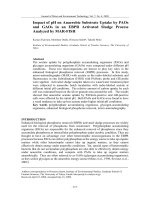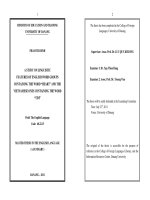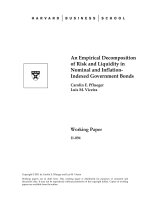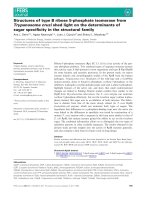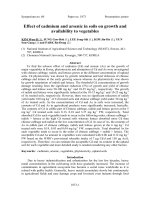STANDARD ON INTERNAL AUDIT (SIA) 17 CONSIDERATION OF LAWS AND REGULATIONS IN AN INTERNAL AUDIT ppt
Bạn đang xem bản rút gọn của tài liệu. Xem và tải ngay bản đầy đủ của tài liệu tại đây (64.36 KB, 16 trang )
STANDARD ON INTERNAL AUDIT (SIA) 17
CONSIDERATION OF LAWS AND REGULATIONS IN AN
INTERNAL AUDIT
Contents
Paragraph(s)
Scope 1
Definition 2
Effect of Laws and Regulations 3-4
Responsibility of Management for Compliance with
Laws and Regulations 5-6
Objectives 7
Responsibility of the Internal Auditor 8-21
The Internal Auditor’s Consideration of Compliance with Laws
and Regulations 22-31
Internal Audit Procedures When Non-Compliance is
Identified or Suspected 32-40
Reporting of Identified or Suspected Non-Compliance 41-45
Documentation 46-47
Effective Date 48
The following is the text of the Standard on Internal Audit (SIA) 17,
Consideration of Laws and Regulations in an Internal Audit, issued by the
Institute of Chartered Accountants of India. The Standard should be read in
the conjunction with the “Preface to the Standards on Internal Audit”, issued
by the Institute.
In terms of the decision taken by the Council of the Institute at its 260
th
meeting held in June 2006, the following Standard on Internal Audit shall be
recommendatory in nature in the initial period. The Standard shall become
mandatory from such date as may be notified by the Council in this regard.
Standard on Internal Audit (SIA) 17
2
Scope
1. This Standard on Internal Audit (SIA) deals with the internal auditor’s
responsibility to consider laws and regulations when performing an internal audit.
This SIA also applies to other engagements in which the internal auditor is
specifically engaged to test and report separately on compliance with specific
laws or regulations.
Definition
2. For the purposes of this SIA, the following term has the meaning
attributed below:
Non-compliance – Acts of omission or commission by the entity, either
intentional or unintentional, which are contrary to the prevailing laws or
regulations. Such acts include transactions entered into by, or in the name of, the
entity, or on its behalf, by those charged with governance, management or
employees. Non-compliance does not include personal misconduct (unrelated to
the business activities of the entity) by those charged with governance,
management or employees of the entity.
Effect of Laws and Regulations
3. The effect on the functioning of an entity of laws and regulations varies
considerably. Those laws and regulations to which an entity is subject to
constitute the legal and regulatory framework. The provisions of some laws or
regulations have a direct effect on the financial statements in that they determine
the reported amounts and disclosures in an entity’s financial statements. Other
laws or regulations are to be complied with by management or set the provisions
under which the entity is allowed to conduct its business but do not have a direct
effect on an entity’s financial statements. Some entities operate in heavily
regulated sectors (such as banking, non-banking finance, insurance, telecom,
etc.). Others are subject only to the many laws and regulations that relate
generally to the operating aspects of the business (such as those related to
environment, occupational safety and health).
4. Non-compliance with laws and regulations may result in fines, litigation
or other consequences for the entity that may have a material effect on not only
the reporting framework of the financial statements but also on the functioning of
Consideration of Laws and Regulations in an Internal Audit
3
the entity and which in extreme cases may impair their ability to continue as a
going concern itself.
Responsibility of Management for Compliance with Laws
and Regulations
5. It is the primary responsibility of management, with the oversight of
those charged with governance, to ensure that the entity’s operations are
conducted in accordance with the provisions of laws and regulations, including
compliance with the provisions of laws and regulations that determine the
reported amounts and disclosures in an entity’s financial statements.
6. The following are examples of the types of policies and procedures an
entity may implement to assist in the prevention and detection of non-compliance
with laws and regulations:
Monitoring legal requirements and ensuring that operating procedures are
designed to meet these requirements.
Instituting and operating appropriate systems of internal control.
Developing, publicising and following a code of conduct. Ensuring
employees are properly trained and understand the code of conduct.
Monitoring compliance with the code of conduct and acting appropriately to
discipline employees who fail to comply with it.
Targeting information for compliance to those employees or departments
who are in the best position to verify possibilities of non-compliance.
Engaging legal advisors to assist in monitoring legal requirements.
Maintaining a register of significant laws and regulations with which the
entity has to comply within its particular industry and a record of complaints.
These policies and procedures may be supplemented by assigning appropriate
responsibilities to the following:
A compliance function.
An audit committee.
Standard on Internal Audit (SIA) 17
4
Objectives
7. The objectives of the internal auditor are:
(a) To obtain sufficient appropriate audit evidence regarding compliance with
the provisions of those laws and regulations generally recognised to have a
direct effect on the determination of material amounts and disclosures in
the financial statements;
(b) To perform specified audit procedures to help identify instances of non-
compliance with other laws and regulations that may have a significant
impact on the functioning of the entity; and
(c) To respond appropriately to non-compliance or suspected non-compliance
with laws and regulations identified during the internal audit.
Responsibility of the Internal Auditor
8. Paragraph 3.1 of the “Preface to the Standards on Internal Audit”,
issued by the Council of the Institute of Chartered Accountants of India in 2007,
describes internal audit as follows:
"Internal audit is an independent management function, which involves a
continuous and critical appraisal of the functioning of an entity with a view
to suggest improvements thereto and add value to and strengthen the
overall governance mechanism of the entity, including the entity's strategic
risk management and internal control system.”
9. Compliance with laws and regulations is an inherent part of the
functioning of an entity. Since the role of an internal auditor is to carry out a
continuous and critical appraisal of the functioning of an entity and suggest
improvements thereto, the identification of non-compliance with laws and
regulations is also an inherent part of his responsibilities. It will be pertinent to
add here that the scope of an internal audit as described in paragraph 9 of the
Standard on Internal Audit (SIA) 1, “Planning an Internal Audit”, is also affected
by the statutory or regulatory framework in which the entity operates.
10. Unlike the statutory audit function, in which the auditor is responsible for
identification of non-compliance with the laws and regulations with a view to
Consideration of Laws and Regulations in an Internal Audit
5
obtain reasonable assurance that the financial statements, taken as a whole, are
free from material misstatements, whether caused by fraud or error, the
responsibilities of an internal auditor are much wider. As discussed in Para 3 (v)
of the Standard on Internal Audit (SIA) 1, “Planning an Internal Audit”, internal
audit helps, inter alia, amongst other things, in ensuring compliance with the
applicable statutory and regulatory requirements.
11. The scope of internal audit is determined by the terms of engagement of
the internal audit activity whether carried out in house or by an external agency.
Hence, in the case of an internal audit, the terms of engagement are variable and
have an impact on the responsibility of the management vis a vis the internal
auditor. The terms of engagement amongst other things, generally, require the
internal auditor to examine the status of compliance with various statutes
governing the entity. Even in the absence of an explicit mention in the terms of
the engagement, the internal auditor has to verify compliance with laws and
regulations within the overall objectives of an internal audit, as discussed in
paragraph 2 of the Standard on Internal Audit (SIA) 1, “Planning an Internal
Audit” which are as follows:
to suggest improvements to the functioning of the entity; and
to strengthen the overall governance mechanism of the entity, including its
strategic risk management as well as internal control system.
12. Paragraph 8 of the Standard on Internal Audit (SIA) 12, “Internal Control
Evaluation”, describes that the internal audit function adds value to an
organisation’s internal control system by bringing a systematic, disciplined
approach to the evaluation of risks and by making recommendations to
strengthen the effectiveness of risk management efforts. Further, as discussed in
paragraph 10 of the Standard on Internal Audit (SIA) 12, one of the broad areas
of review by the internal auditor in evaluating the internal control system, inter
alia, includes accounting and financial reporting policies and compliance with
applicable legal and regulatory standards.
13. At the same time, as discussed in paragraphs 8 and 9 of the Standard
on Internal Audit (SIA) 12, it may be noted that though the internal auditor’s
evaluation of internal control involves assessing non-compliance with laws and
regulations, the internal auditor is not vested with the management’s primary
responsibility for designing, implementing, maintaining and documenting internal
control.
Standard on Internal Audit (SIA) 17
6
14. Paragraph 9 of the Standard on Internal Audit (SIA) 13, “Enterprise Risk
Management”, describes that “the internal auditor should not manage any of
the risks on behalf of the management or take risk management decisions.
The internal auditor should not assume any accountability for risk
management decisions taken by the management. Internal auditor has a role
only in advising on risk management and assisting in the effective mitigation of
risk.”
15. The internal auditor is expected to exercise due professional care while
carrying out the internal audit in detecting non-compliance with laws and
regulations. As discussed in paragraph 6 of the Standard on Internal Audit (SIA)
2, “Basic Principles Governing Internal Audit”, due professional care, however,
neither implies nor guarantees infallibility, nor does it require the internal auditor
to travel beyond the scope of his engagement.
16. The requirements in this SIA are designed to assist the internal auditor
in identifying the significant impact of non-compliance with laws and regulations
on the functioning of the entity. However, in view of the inherent limitations on the
role of the internal auditor as discussed above, the internal auditor is not
responsible for preventing non-compliance and cannot be expected to detect
non-compliance with all laws and regulations.
17. In conducting an internal audit of an entity, the internal auditor takes into
account the applicable legal and regulatory framework. Owing to the inherent
limitations of an internal audit, there is an unavoidable risk that some non-
compliances with laws and regulations and consequential material
misstatements in the financial statements may not be detected, even though the
internal audit is properly planned and performed in accordance with the SIAs. In
the context of laws and regulations, the potential effects of inherent limitations on
the internal auditor’s ability to detect non-compliance are greater for such
reasons as the following:
There are many laws and regulations, relating principally to the operating
aspects of an entity that typically do not affect the financial statements
and are not captured by the entity’s information systems relevant to
financial reporting.
Non-compliance may involve conduct designed to conceal it, such as
collusion, forgery, deliberate failure to record transactions, management
override of controls or intentional misrepresentations being made to the
Consideration of Laws and Regulations in an Internal Audit
7
internal auditor.
Whether an act constitutes non-compliance is ultimately a matter for legal
determination by a court of law.
Ordinarily, the further removed non-compliance is from the events and
transactions captured or reflected in the entity’s information systems relevant to
financial reporting, the less likely the internal auditor is to become aware of it or
to recognise the non-compliance.
18. This SIA distinguishes the internal auditor’s responsibilities in relation to
compliance with two different categories of laws and regulations as follows:
(a) The provisions of those laws and regulations generally recognised to
have a direct effect on the determination of material amounts and
disclosures in the financial statements such as tax and laws regulating the
reporting framework; and
(b) Other laws and regulations that do not have a direct effect on the
determination of the amounts and disclosures in the financial statements,
but compliance with which may be fundamental to the operating aspects of
the business, to an entity’s ability to continue its business, or to avoid
material penalties (for example, compliance with the terms of an operating
license, compliance with regulatory solvency requirements, or compliance
with environmental regulations). Non-compliance with other laws and
regulations may result in fines, litigation or other consequences for the
entity, the costs of which may need to be provided for in the financial
statements, or may even have a significant impact on the operations of the
entity, but are not considered to have a direct effect on the financial
statements, as described in paragraph 18(a). Non-compliance with laws
and regulations that have a significant impact on the operations of the entity
may cause the entity to cease operations, or call into question the entity’s
continuance as a going concern. For example, non-compliance with the
requirements of the entity’s license or other entitlement to perform its
operations could have such an impact (for example, for a bank, non-
compliance with capital or investment requirements). To illustrate further, a
Non Banking Financial Company might have to cease to carry on the
business of a non-banking financial institution if it fails to obtain a certificate
of registration issued under Chapter III B of the Reserve Bank of India Act,
1934 and if its Net Owned Funds are less than the amount specified by the
Standard on Internal Audit (SIA) 17
8
RBI in this regard. There are also many laws and regulations relating
principally to the operating aspects of the entity that typically do not affect
the financial statements and are not captured by the entity’s information
systems relevant to financial reporting. An example here could be an airline
failing to meet the safety norms prescribed by the government leading to an
uncertainty over continuance of its license to operate. Non-compliance with
such laws and regulations may, therefore, have a significant impact on the
functioning of an entity.
19. In this SIA, differing requirements are specified for each of the above
categories of laws and regulations.
For the category referred to in paragraph 18(a), the internal auditor’s
responsibility is to obtain sufficient appropriate audit evidence, in
accordance with the Standard on Internal Audit (SIA) 10, “Internal Audit
Evidence”, about compliance with the provisions of those laws and
regulations.
For the category referred to in paragraph 18(b), the internal auditor’s
responsibility is limited to undertaking specified audit procedures to help
identify non-compliance with those laws and regulations that may have
a significant impact on the functioning of the entity.
20. Non-compliance by the entity with laws and regulations may result in a
material misstatement of the financial statements and in some cases, may
impact significantly the functioning of the entity itself. Whether an act constitutes
non-compliance with laws and regulations is a matter for legal determination,
which is ordinarily beyond the internal auditor’s professional competence to
determine. Paragraph 2 of Standard on Internal Audit (SIA) 16, “Using the Work
of an Expert” states as follows:
“The internal auditor should obtain technical advice and assistance from
competent experts if the internal audit team does not possess the
necessary knowledge, skills, expertise or experience needed to perform all
or part of the internal audit engagement.”
Nevertheless, the internal auditor’s training, experience and understanding of the
entity and its industry or sector may provide a basis to recognise that some acts,
coming to the internal auditor’s attention, may constitute non-compliance with
Consideration of Laws and Regulations in an Internal Audit
9
laws and regulations.
21. The internal auditor may have a specific responsibility, one that may
arise out of the terms of engagement or a law or a regulation or a standard
applicable to the internal auditor, to communicate directly, the above mentioned
issues to an appropriate authority within the entity or a regulator. In these
circumstances, Standards on Internal Audit, SIA 4, “Reporting” and SIA 8,
“Terms of Internal Audit Engagement”, deal with how these audit
responsibilities should be addressed in the internal auditor’s report.
Furthermore, where there are specific statutory reporting requirements, it may be
necessary for the internal audit plan to include appropriate tests for compliance
with those provisions of the laws and regulations.
The Internal Auditor’s Consideration of Compliance with
Laws and Regulations
Obtaining an Understanding of the Legal and Regulatory Framework
22. As part of obtaining an understanding of the entity and its environment
in accordance with Standard on Internal Audit (SIA) 15, “Knowledge of the Entity
and its Environment”, the internal auditor shall obtain a general understanding of:
(a) The legal, regulatory and the financial reporting framework applicable to the
entity and the industry or sector in which the entity operates; and
(b) How the entity is complying with that framework.
To obtain a general understanding of such a legal and regulatory framework, and
how the entity complies with that framework, the internal auditor may, for
example:
Use the internal auditor’s existing understanding of the entity’s industry,
regulatory and other external factors;
Update the understanding of those laws and regulations that directly
determine the reported amounts and disclosures in the financial
statements;
Inquire of management as to other laws or regulations that may be
expected to have a significant effect on the operations of the entity;
Standard on Internal Audit (SIA) 17
10
Inquire of management concerning the entity’s policies and procedures
regarding compliance with laws and regulations as well as ethical issues
within the entity; and
Inquire of management regarding the policies or procedures adopted for
identifying, evaluating and accounting for litigation claims.
Laws and Regulations Generally Recognised to have a Direct Effect
on the Determination of Material Amounts and Disclosures in the
Financial Statements
23. Certain laws and regulations are well-established, known to the entity
and within the entity’s industry or sector, and relevant to the entity’s financial
statements (as described in paragraph 18(a)). They could include those that
relate to, for example:
The form and content of financial statements;
Industry-specific financial reporting issues;
Accounting for transactions under government contracts; or
The accrual or recognition of expenses for income tax or retirement
benefits.
24. Some matters may be relevant to specific assertions (for example, the
completeness of income tax provisions), while others may be relevant to the
financial statements as a whole (for example, the required statements
constituting a complete set of financial statements).
25. The internal auditor shall obtain sufficient appropriate audit evidence
regarding compliance with the provisions of those laws and regulations generally
recognised to have a direct effect on the determination of material amounts and
disclosures in the financial statements.
Procedures to Identify Instances of Non-Compliance – Other Laws
and Regulations
26. The internal auditor shall perform the following audit procedures to help
identify instances of non-compliance with other laws and regulations that may
have a significant impact on the entity’s functioning:
Consideration of Laws and Regulations in an Internal Audit
11
(a) Inquiring of management and, where appropriate, those charged with
governance, as to whether the entity is in compliance with such laws and
regulations; and
(b) Inspecting correspondence, if any, with the relevant licensing or regulatory
authorities.
27. As the financial reporting consequences of other laws and regulations
can vary depending on the entity’s operations, the internal audit procedures
required by paragraph 26 are directed to bringing to the internal auditor’s
attention instances of non-compliance with laws and regulations that may have a
significant impact on the functioning of the entity.
Non-Compliance brought to the Internal Auditor’s Attention through
Other Audit Procedures
28. During the internal audit, the internal auditor shall remain alert to the
possibility that other audit procedures applied may bring instances of non-
compliance or suspected non-compliance with laws and regulations to the
internal auditor’s attention. For example, such audit procedures may include:
Reading minutes;
Inquiring of the entity’s management and in-house legal counsel or external
legal counsel concerning litigation, claims and assessments; and
Performing substantive tests of details of classes of transactions, account
balances or disclosures.
Written Representations
29. The internal auditor shall request management and, where appropriate, those
charged with governance to provide written representations that all known
instances of non-compliance or suspected non-compliance with laws and
regulations which impact the functioning of the entity, including the reporting
framework, have been disclosed to the internal auditor.
30. Because the effect of non-compliance on the functioning of an entity
can vary considerably, written representations provide necessary audit evidence
about management’s knowledge of identified or suspected non-compliance with
Standard on Internal Audit (SIA) 17
12
laws and regulations, whose effects may have a significant impact on the
functioning of the entity. However, written representations do not provide
sufficient appropriate audit evidence on their own and, accordingly, do not
affect the nature and extent of other audit evidence that is to be obtained by the
internal auditor.
Internal Audit Procedures When Non-Compliance is Not Identified or
Suspected
31. In the absence of identified or suspected non-compliance, the internal
auditor is not required to perform audit procedures regarding the entity’s
compliance with laws and regulations, other than those set out in
paragraphs 22-30.
Internal Audit Procedures When Non-Compliance is
Identified or Suspected
32. If the internal auditor becomes aware of information concerning an
instance of non-compliance or suspected non-compliance with laws and
regulations, the internal auditor shall obtain:
(a) An understanding of the nature of the act and the circumstances in which it
has occurred; and
(b) Further information to evaluate the possible effect on the functioning of the
entity.
Indications of Non-Compliance with Laws and Regulations
33. When the internal auditor becomes aware of the existence of, or
information about, the following matters, it may be an indication of non-
compliance with laws and regulations:
Investigations by regulatory organisations and government departments or
payment of fines or penalties.
Payments for unspecified services or loans to consultants, related parties,
employees or government employees.
Sales commissions or agent’s fees that appear excessive in relation to
those ordinarily paid by the entity or in its industry or to the services actually
Consideration of Laws and Regulations in an Internal Audit
13
received.
Purchasing at prices significantly above or below market price.
Unusual payments in cash, purchases in the form of cashiers’ cheques
payable to bearer or transfers to numbered bank accounts.
Unusual payments towards legal and retainership fees.
Unusual transactions with companies registered in tax havens.
Payments for goods or services made other than to the country from which
the goods or services originated.
Payments without proper exchange control documentation.
Existence of an information system which fails, whether by design or by
accident, to provide an adequate audit trail or sufficient evidence.
Unauthorised transactions or improperly recorded transactions.
Adverse media comment.
Matters Relevant to the Internal Auditor’s Evaluation
34. Matters relevant to the internal auditor’s evaluation of the possible effect
on the entity’s functioning include:
The potential financial consequences of non-compliance with laws and
regulations on the functioning of the entity including, for example, the
imposition of fines, penalties, damages, threat of expropriation of assets,
enforced discontinuation of operations and litigation.
Whether the potential financial consequences need to be informed to the
management for the limited objective of suitable disclosure.
Whether the potential financial consequences are so serious as to call into
question the ability of the entity to continue as a going concern.
35. The internal auditor may discuss the findings with those charged with
governance where they may be able to provide additional audit evidence. For
example, the internal auditor may confirm that those charged with governance
have the same understanding of the facts and circumstances relevant to
Standard on Internal Audit (SIA) 17
14
transactions or events that have led to the possibility of non-compliance with
laws and regulations.
36. If the internal auditor suspects there may be non-compliance, the
internal auditor shall discuss the matter with management and, where
appropriate, those charged with governance. If management or, as appropriate,
those charged with governance do not provide sufficient information to the
internal auditor that the entity is in fact in compliance with laws and regulations,
the internal auditor may consider it appropriate to consult with the entity’s in-
house legal counsel or external legal counsel about the application of the laws
and regulations to the circumstances, including the possibility of fraud, and the
possible impact on the functioning of the entity. When it is not considered
appropriate to consult with the entity’s legal counsel or when the internal auditor
is not satisfied with the legal counsel’s opinion, the internal auditor may consider
it appropriate to consult the internal auditor’s own legal counsel as to whether a
contravention of a law or regulation is involved, the possible legal consequences,
including the possibility of fraud in accordance with the Standard on Internal
Audit (SIA) 11, “Consideration of Fraud in an Internal Audit”, and what further
action, if any, the internal auditor would take.
37. If sufficient information about suspected non-compliance cannot be
obtained, the internal auditor shall evaluate the effect of the lack of sufficient
appropriate audit evidence on the internal auditor’s observations and findings.
Evaluating the Implications of Non-Compliance
38. The internal auditor shall evaluate the implications of non-compliance in
relation to other aspects of the internal audit, including the internal auditor’s risk
assessment and the reliability of written representations, and take appropriate
action.
39. The implications of particular instances of non-compliance identified by
the internal auditor will depend on the relationship of the perpetration and
concealment, if any, of the act to specific control activities and the level of
management or employees involved, especially implications arising from the
involvement of the highest authority within the entity.
40. In exceptional cases, the internal auditor may consider whether, unless
Consideration of Laws and Regulations in an Internal Audit
15
prohibited by law or regulation, withdrawal from the engagement is necessary
when management or those charged with governance do not take the remedial
action that the internal auditor considers appropriate in the circumstances. When
deciding whether withdrawal from the engagement is necessary, the
internal auditor should consider whether there is an obligation, contractual
or otherwise to report the circumstances necessitating the withdrawal to
other parties.
Reporting of Identified or Suspected Non-Compliance
Reporting Non-Compliance to Those Charged with Governance
41. Unless all of those charged with governance are involved in
management of the entity, and therefore are aware of matters involving identified
or suspected non-compliance already communicated in accordance with the
Standard on Internal Audit (SIA) 9, “Communication with Management”, by the
internal auditor, the internal auditor shall communicate with those charged with
governance matters involving non-compliance with laws and regulations that
come to the internal auditor’s attention during the course of the internal audit,
other than when the matters are clearly inconsequential.
42. If, in the internal auditor’s judgment, the non-compliance referred to in
paragraph 41 is believed to be intentional and material, the internal auditor shall
communicate the matter to those charged with governance as soon as
practicable.
Reporting Non-Compliance in the Internal Auditor’s Report
43. If the internal auditor concludes that the non-compliance has a
significant impact on the functioning of an entity and has not been adequately
dealt with by the management, the internal auditor shall report the same in
accordance with SIA 4, “Reporting”.
44. If the internal auditor is precluded by management or those
charged with governance from obtaining sufficient appropriate audit
evidence to evaluate whether non-compliance that may be significant to
the functioning of the entity has, or is likely to have, occurred, the internal
auditor should report the same in accordance with SIA 4, “Reporting”.
45. If the internal auditor is unable to determine whether non-compliance
Standard on Internal Audit (SIA) 17
16
has occurred because of limitations imposed by the circumstances rather than by
management or those charged with governance, the internal auditor shall
evaluate the effect on the internal auditor’s observations and findings in
accordance with SIA 4, “Reporting”.
Documentation
46. The internal auditor shall document identified or suspected non-
compliance with laws and regulations and the results of discussion with
management and, where applicable, those charged with governance and other
parties outside the entity in accordance with the Standard on Internal Audit (SIA)
3, “Documentation”.
47. The internal auditor’s documentation of findings regarding identified or
suspected non-compliance with laws and regulations may include, for example:
Copies of records or documents.
Minutes of discussions held with management, those charged with
governance or parties outside the entity.
Effective Date
48. This Standard on Internal Audit (SIA) is effective for all internal audits
beginning on or after ……… Earlier application of the SIA is encouraged.
